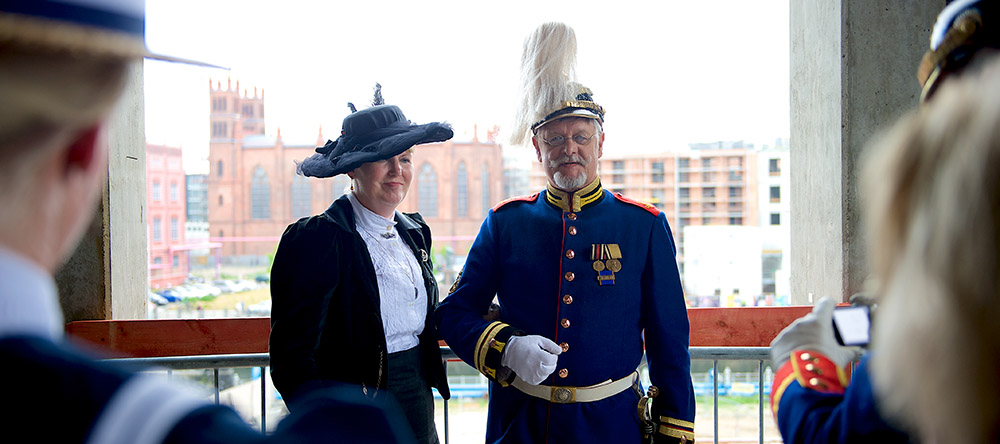The emperor’s new clothes
For a few years now, the centre of Berlin has been dominated by a huge construction site: the Berlin City Palace. Built in its original form in 1442 by the Hohenzollern dynasty, it was then permanently rebuilt over the centuries, baroqueised and greatly extended by Schlüter around 1700, until Schinkel finally gave it the dome and an imposing north portal in the late 19th century. After the emperor fled in 1918, the republic was proclaimed here, but it remained largely unused during this period, was badly damaged by Allied bombs during the Second World War and finally burnt down completely in February 1945. City architect Hans Scharoun began restoration work after the war, but in the newly founded GDR the political will against this powerful symbol of the Prussian state was so strong that it was finally demolished in December 1950. The Palace of the Republic was erected in its place as a political symbol. The triumph of socialism over the vanished Prussia.
As is well known, socialism did not last too long. After the fall of the GDR, the palace continued to serve as a cultural venue for a while, but it was such a thorn in the side of the Federal Republic that it was finally demolished in 2006 despite extensive asbestos removal. It was a bit like two small children destroying each other’s sandcastles. Instead of organising an international architectural competition and setting a great visionary example for the modern and open Federal Republic of Germany of the 21st century, the German Bundestag, completely lacking any vision, decided to simply rebuild the good old city palace in exactly the same place, hoping to revive the Schlüter/Schinkel spirit and use it to revive Berlin’s centre to its former greatness. But ironically, the federal government is only paying for the shell of the building. The stucco elements of the façade are sold by the “Freundeskreis Berliner Schloss” via its webshop (“The palace in individual parts: from partial building blocks for 50 euros to capitals for 179,900 euros”). Currently, around 45% of the façade has been completed.
Unfortunately, the entire palace project lacks not only an urban planning vision, but also a decisive idea of what the box could actually be used for. Even if one or two Berliners would certainly be delighted if the dashing cuirassiers rode around Unter den Linden again and occasionally waved a few crown princesses out of the window, a real emperor is unfortunately not in sight at the moment. Instead, the focus is on dressing up the “Humboldt Forum“, a kind of interdisciplinary meta-exhibition in which ethnology meets modernity, garnished with lectures, student research projects and all kinds of scientific fuss. The ethnological collections currently stored in the rather cool Museum für Völkerkunde in Dahlem are supposed to form the centrepiece of the whole shebang. However, the decision in favour of this idea was made too late and the architects have already decided on the interior design, which means that some of the large exhibits from Dahlem, such as the longboats, will not fit into the palace. No matter. So the small and medium-sized exhibits will be in the palace and the large ones in Dahlem. It’s lucky that the statues of the Humboldts in front of the nearby Humboldt University stoically look straight ahead and don’t have to watch the nearby misery.
But there is also good news to report from the palace: in contrast to the major international airport BER, the project has not only remained on schedule and within budget, but has also set itself the task of bringing the “palace” project closer to the public and has already scheduled the second shell inspection this year. As always when there is something for free, the people of Berlin have seized this opportunity with great enthusiasm and, if I interpret the mood among the population correctly, they feel a little more exalted now that the palace is gradually taking shape. “Berlin is the palace and the palace is Berlin”, as I was allowed to hear myself say in the face of criticism that I gently voiced. Now Berlin wouldn’t be Berlin if a spontaneous counter-movement hadn’t immediately formed, which is already organising a collection for the renewed demolition of the newly built palace. However, in view of the barbarity of IS, which is currently razing one ancient site after another in Iraq and Syria, this seems to me to be the wrong step. If the people of Berlin really want the old box back, they should be happy with it. But it is astonishing how quickly the old spirit that once blew through the building is rising again. And it is not the sublime spirit of Schlüter and Schinkel as we had hoped, it is the spirit of Prussian militarism, of dashing officers and their pretty ladies, with sabres and polished brass and fine manners and everything that goes with it. It takes a lot of canoes and tipis to break this spirit.
See for yourself:




